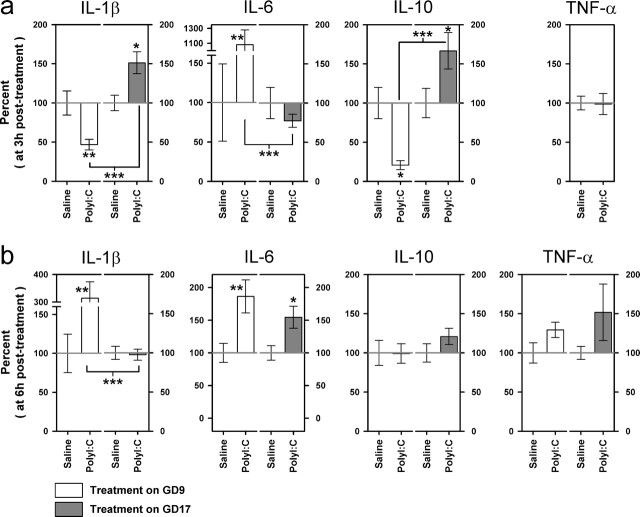Figure 8.
Comparison of the fetal brain cytokine responses after immune challenge in middle and late gestation in terms of relative protein levels. The average fetal brain cytokine levels obtained per progeny (n = 3–5 fetuses per progeny) in the two prenatal PolyI:C conditions (GD9 or GD17) are expressed as percentage of deviation from the mean levels obtained after saline treatment conducted on the same gestation day and at the corresponding post-treatment sampling intervals (3 or 6 h). a, Maternal PolyI:C exposure on GD9 reduced the relative IL-10 protein contents in fetal brain tissue compared with vehicle (saline) treatment and led to a massive elevation of the relative fetal brain IL-6 levels at 3 h after treatment. Conversely, the same treatment conducted on GD17 exerted opposite effects on both cytokines at this sampling time. In addition, the relative protein contents of fetal brain IL-1β were only increased after maternal PolyI:C treatment on GD17, as opposed to the marginal reduction observed in GD9-PolyI:C offspring 3 h after treatment. b, At 6 h after treatment, however, a marked elevation IL-1β was detected in the brain of GD9 PolyI:C-exposed offspring, and the relative protein levels of fetal brain IL-6 were increased in PolyI:C-treated offspring independent of treatment times. The number of pregnant dams in each group was 4, except in the following three groups: GD9-PolyI:C/3 h, n = 6; GD17-PolyI:C/3 h, n = 5; GD17-PolyI:C/6 h, n = 5. The levels of TNF-α on GD9 were below detection limits 3 h after treatment. All values are mean ± SEM. ∗p < 0.05, ∗∗p < 0.01, and ∗∗∗p < 0.001, statistical significance based on independent Student's t tests between the effects of PolyI:C treatment on GD9 (GD9-PolyI:C vs GD9-saline) and on GD17 (GD17-PolyI:C vs GD17-saline), as well as between the efficacy of PolyI:C treatment at the two treatment days (GD9-PolyI:C vs GD17-PolyI:C) at each sample interval (3 or 6 h).

